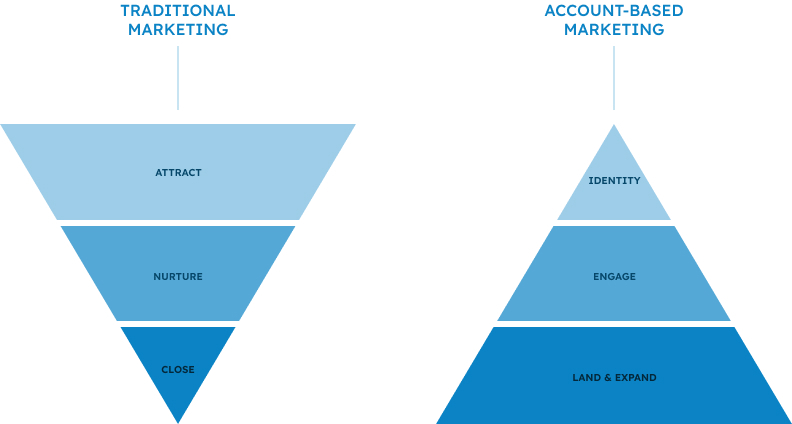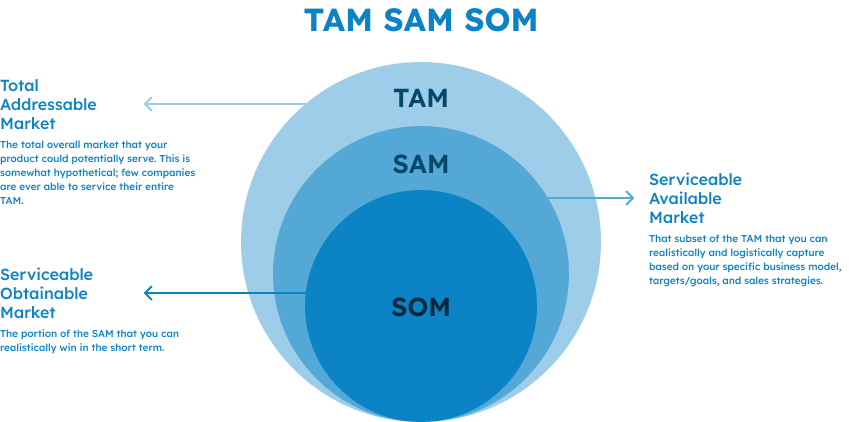Account-based marketing (ABM) is a marketing strategy that focuses efforts on a predetermined list of target accounts. ABM practitioners use highly customized, personalized campaigns designed to engage each contact within the target accounts. Also known as Key Account Marketing, the ABM approach requires persistence and the use of all available channels to engage contacts at high-value accounts. Coupled with Inbound Marketing, HubSpot offers ABM functionality so users can better align marketing and sales teams while streamlining the sales process.
What is Account-Based Marketing (ABM)?

Account-Based Marketing (ABM) has been practiced for more than two decades. The term was coined in 2004 by the ITSMA ABM certification. B2B sales teams of all shapes and sizes have used ABM tactics for many years.
In short, ABM provides companies with a focus and a concentration of resources on selling to a short list of highly-valued, key accounts using a multi-channel approach.
ABM is often referred to as Key Account Marketing or Target Marketing, some thought leaders call it “flipping the funnel.” ABM comes with a complete set of unique terminology as well.
How Does ABM Fit Into Sales & Marketing Strategies?

In contrast with traditional B2B marketing and sales funnels, ABM tactics include identifying the customer first. Next, developing an appropriate plan of action. Then work to establish relationships with key stakeholders - all of the key stakeholders. And finally, create a demand for your product/service.
This may initially seem contradictory to HubSpot’s core philosophies, as they are the leading proponent of Inbound Marketing. However, with ABM, marketers can expand HubSpot’s concept of “right message to the right person at the right time” to include all of the right people, not just one person that makes their way into your CRM. Since B2B purchasing decisions involve an increasing number of individuals, it’s becoming more difficult to generate qualified sales opportunities with the traditional, lead-based methods alone.

Proponents of ABM argue that more traditional lead generation strategies rely too heavily on large volumes and are hampered by differing objectives between sales and marketing. Additionally, strategies that depend on a linear process and having prospects advanced down a theoretical funnel are susceptible to misalignment and cause adversarial relationships. And, worst of all, far too many potential buyers are lost at various points in the buyer’s journey without explanation. All in all, lead-based marketing tactics render a smaller overall count of legitimate sales opportunities and waste valuable resources.
Account-Based Marketing can easily fit into your existing sales and marketing strategies because of its sharp focus on a small percentage of your Total Addressable Market (TAM). In the initial stages of deploying the ABM strategy, the Target Accounts are determined based on those organizations that are considered to be the best fit for your offerings.
In addition to other strategies being used, the contacts at these pre-selected key accounts receive highly personalized, special attention. For example, invitations to dinners, unique gifts or swag are sent to grab attention and establish a relationship. Unlike the tactics used on a wide audience, ABM requires a lot of manual steps, one-to-one outreach, and is difficult to scale. So the chance of your ABM efforts clashing with other methods is very low.
How to Plan Your ABM Tactics

Begin with the end in mind, your primary objective:
- Top of funnel demand generation?
- Pipeline acceleration?
- Cross-selling or upselling your existing customers?
There are several potential purposes for running an ABM strategy. For maximum effect, choose a primary objective and then build your campaigns using a framework to achieve it.
Next, choose a framework upon which you can build your ABM strategy.
As previously mentioned, ITSMA was first to use the term Account-Based Marketing back in 2004. Their framework includes seven pillars for success. Those pillars being:
- Strategy & Sales Alignment
- Objectives & Metrics
- Account Selection & Segmentation
- Program Operations & Resources
- Content & Campaigns
- Data, Analytics, & Insights
- Technology Infrastructure
Another approach is called TEAM. Introduced by the popular ABM platform from Terminus, the TEAM acronym stands for Target, Engage, Activate, and Measure.
The four components of this framework can be described as:
- T - Target: Create your short list of best-fit accounts you desire as customers
- E - Engage: Develop and deliver multi-channel, personalized messaging to contacts at our Target Accounts
- A - Activate: Collaboration between sales and marketing to advance accounts forward in your sales pipeline
- M - Measure: Track pipeline, closed won revenue, new logos, average deal size, etc. to identify way to optimize your ABM efforts
- Intent Data - the valuable information that calculates a prospect's level of interest in a specific product or service through online activities. This data includes prospects' web searches, the pages they visit, and the content they actively engage with.
- Account Intelligence Data - information gathered about a target account from data collected and analyzed. The data often includes details about the company, their organizational structure, identified decision makers, previous interactions with members of the company, and other relevant information.
- Predictive Analytics - an attempt to identify patterns and make predictions based on four key elements, those being data collected, data models, data evaluation, and statistical algorithms deployed.
- Account Tiering - a strategy to assist sales representatives with segmenting and prioritizing accounts based on criteria such as industry, size, potential sales revenue, and so forth. The higher the Tier, the more resources are allocated to closing sales with the accounts.
- Firmographics - the descriptive characteristics of a company to provide insights into their size, industry, location, business model, and other relevant information. Used in marketing to classify and categorize companies for more meaningful messaging in outreach efforts.
- Demographics - similar to firmographics, demographics describe aspects of people, such as age, gender, income, education, job function, and other data points. Used by marketing to group like contacts to deliver customized communications that bring higher value to the contacts.
Start by Selecting Your Target Accounts

As with other strategies, it's important to identify your audience. For those who are new to ABM, this can be a challenge to realize that not everyone is a good fit to buy from you. Marketing can lead the way when helping sales boil down the entire market into manageable lists using a top-down approach. Before selecting the individual accounts to include in your ABM campaigns, start with determining the Total Addressable Market or TAM. The TAM is more theoretical than practical. It is the list of all the organizations that could possibly buy your solutions. Unless you have a monopoly, the opportunity to actually sell something to everyone in your TAM is virtually nil. So, deploying any ABM efforts against your TAM isn’t an effective strategy.
Suppose you have a well-defined TAM, next you need to whittle that list down to which of those accounts you can actually expect to reach and engage. Those would be considered your SAM, or Serviceable Addressable Market. These accounts earn their place in your SAM by way of firmographics, demographics, industry, size, location, and revenue. The SAM is also somewhat theoretical as you need to determine your ability to realistically serve them with the resources you have available. You can think of these accounts as potential customers over the next three to five years. So, although this list has been culled from the TAM, it is still not honed to a point that fits an ABM model.
Once you complete your SAM, you will then break the list down ever further into those you can realistically land as new customers. This smaller percentage of the SAM is known as the SOM, or Serviceable Obtainable Market. The organizations in your SOM are deemed as “good fits” based on in-depth research of the industry, the product or service landscape, your competitors, their typically preferred buying model, and your track record of serving accounts who qualify as SOM members.

Another way to identify your key accounts to include in your ABM strategy is to look at your existing customers. Your customers will usually share several characteristics which you can use to create an Ideal Customer Profile or ICP. Armed with your ICP defined, you can then procure lists of organizations that look most similar to your customers. This bottom-up method is a bit of a shortcut and may not be available to you if you have a short history or a small number of existing customers.
Segment Accounts into Priority Tiers

Next, determine your priority accounts and break them down into tiers. Each tier can then be treated with increasing financial value. The highest tier would be those that you consider strategic accounts. You can think of these accounts as your “top 20” or “dream accounts.” These accounts get every resource available and are assigned to a marketing or sales rep in a one-to-one (one-to-very-few) ratio.
The middle tier includes high-value accounts as well, but don’t warrant as much of your attention or allotment of resources. With a little less personalization and a one-to-few ratio your ABM team can incorporate some automation and use some generalized messaging. Leveraging a martech or salestech platform that enables your ABM strategy is critical for increasing your overall reach and scaling your efforts to supplement the one-to-one activities.
Lastly, your third tier of target accounts certainly hold value, so they too get some personalization and custom messaging, but your ABM teams rely more heavily on technology to scale their reach. Many refer to this tier as the “ABM lite” accounts. These accounts may not get quite as much personal, hands-on attention from your sales and marketing team. However, with some preparations these contacts can receive messaging specific to their industry, their job function, and their stage in the buying decision process.
HubSpot’s ABM tools provide the functionality to assign Target Accounts, segment them into Tiers, automate tasks, deliver meaningful messaging, and track and report account-related activities to sales people and their managers.
HubSpot’s Account-Based Marketing Tools

To deploy your ABM strategy using the HubSpot platform you will need to have at least a Professional license for Marketing Hub or Sales Hub.

Before jumping into the Target Accounts page, you must first import your pre-selected accounts. You’ll want to import the Company record details as well as any associated Contacts with each Company. Keep in mind that ABM is an account-centric philosophy, so get whatever company details you can for the initial import. HubSpot AI will also provide any company information available, providing that you supply the company domain name in your list.
Once imported, the file will appear on a list of past imports. From there you can select “View > View Companies” which brings you to a table listing of all the companies from your import. To designate the companies as Target Accounts simply check on the select all box and click the “edit” link in the menu above the table. In the pop up window you can find the Target Accounts property and select “True” for the value.


You may also add companies one at a time by going to the Target Accounts page and clicking on the orange “Choose target accounts” button in the upper right corner and searching for the company by name. However you create your list, you’ll have an account-centric way to view any and all related activities including a roll up of page views, emails, logged calls, meetings and more. Account Owners can use HubSpot to designate which contacts play a role in the buying process. Roles range from Decision Maker to Budget Holder to Blocker and more.
Along with the accounts you’ve worked hard to identify and include in the Target Accounts, HubSpot offers assistance with suggested organizations for you to consider. For example, you may be focused on some federal government agencies and somehow not have NASA on your list. With HubSpot “Prospects” you may get the suggestion based on company similarities and any associated activities, such as this example.

Expected Results of Deploying an ABM Strategy

There are many different benefits to effective Account-Based Marketing. Numerous studies have shown that the ABM approach delivers a higher ROI. In fact, many benchmark studies indicate that it produces the highest ROI compared with any other marketing strategy. Another big benefit of ABM is better teamwork and tighter alignment between sales and marketing teams. The next benefit, and fan favorite of sales teams, is the improved quality of the sales leads. This can be attributed to a couple of factors. First, there are far fewer leads being jammed down the funnel. Second, the targeting process keeps your efforts focused on organizations that are a better fit for your solutions. And, last but not least, over time your ABM tactics will reveal opportunities to streamline your sales processes and better align with your target accounts’ buying process. Meaning, you’ll be able to shorten the sales cycle and close more deals.
- Higher ROI
- Improved Collaboration between Sales and Marketing
- Lead Quality Improves
- Increased Sales Process Efficiencies
Why Partner with 3V for ABM in HubSpot

HubSpot account users have access to a wealth of knowledge and step-by-step guides on how to implement ABM in your account. If you are a beginner, you may consider taking their online course called “Getting Started With Account-Based Marketing (ABM).“ As usual, the knowledge base provides excellent videos and overall good advice, but what it lacks is the ability to give you a tailored training experience based on your unique needs. That’s where hiring a HubSpot Partner comes in.
With Three Ventures, not only do clients get a team of platform-savvy professionals to support you in HubSpot, but clients can more quickly learn and adopt Account-Based Marketing best practices. As long-time strategic consultants, Three Ventures brings several years of real-world ABM strategy experience and knows how to blend the traditional methods with ABM for maximum returns. We also offer several services to help you build on your HubSpot ABM success, such as SEO, social media marketing, website conversion optimization, Google analytics, and more.





















